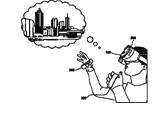Misadventure in English
Last week, our forum ( 论 坛 ) asked if you had any funny or strange stories about using English. Here are some of our favourite posts.
Sophie | When I first visited New York, I went to a shopping centre. I asked a lady where the shoes were. She said they were on the first floor. I went upstairs. But I couldn’t find any. I thought she gave me the wrong information. Then, I realized that the first floor was the ground floor. 128 |
Yancy | I went to a summer school in Manchester. One day, the head master told us that our English teacher Maggie couldn’t teach that day because she had a frog in her throat. Why did she eat a frog? Then I learned that it means someone’s throat is dry or blocked. How funny! 135 |
Julien | My British penfriend once told me that his grandfather was “wicked (邪恶的)”. But when I met his grandfather, I liked him a lot. I found it very strange. Why did my friend use a bad word about such a nice man? Guess what? When speaking informally, “wicked” means “very nice”. 70 |
Zheng Xu | I was part of a student exchange programme between a school in England and one in China. I knew I had done a good job writing my first English paper. But my teacher gave me “Not bad!” Not bad? There weren’t any mistakes! Actually, British people use “not bad” when things are pretty good! I got a good comment! 85 |
1.Who posted the story about buying shoes?
A.Sophie. B.Yancy. C.Julien. D.Zheng Xu.
2.What happened to Maggie?
A.She ate a frog.
B.She had a dry throat.
C.She lost her penfriend.
D.She got a bad comment.
3.What does Julien think of his penfriend’s grandfather?
A.Strange. B.Funny. C.Strict. D.Nice.





